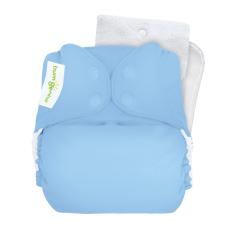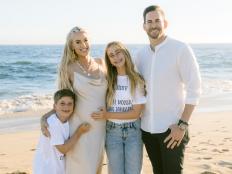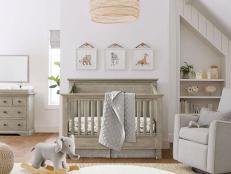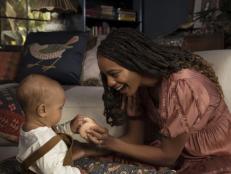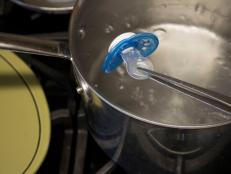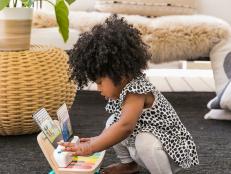Cloth Diapers 101: How to Get Started With Reusable Diapers
Don't let cloth diapering intimidate you. Modern cloth diaper options make it easy for families to transition to cloth diapering at any point during babyhood. Get the tips and insights you need here.

All new parents dream of the day that their child is potty-trained. Not only for convenience, but because the average baby uses thousands of diapers each year. Disposable diapers are a major issue for landfills worldwide and will continue to be an issue for generations to come. Households that begin cloth diapering from birth can reduce their environmental footprint and also experience substantial savings over time. However, you don’t have to start from birth to embrace cloth diapering. Cloth diapers are easy to introduce to all babies and toddlers and — not surprisingly — they’re even an amazing alternative to pull-up diapers if your child is toilet training!

Shutterstock/Soft Light
Whether you’re starting with a newbie or looking to graduate out of disposables, there are many benefits to learning more about cloth diapering.
Fortunately, it isn’t hard to get started once you understand what cloth diapering entails.
Popular Types of Cloth Diapers
Many cloth diapers are made of popular absorbent materials such as bamboo, wool, fleece and organic cotton. In addition, many diapers are also made of hemp, modal, polyester and viscose-based fibers. There are a wide variety of options and combinations favored by cloth diapering families.
The most common designs for cloth diapers include:
Prefolds
Prefold diapers are most similar to the OG cloth diaper secured by safety pins that so many of our parents used in the 1900s. Modern prefolds are built to be a little thicker. They are stitched with more layers in the middle and come in a variety of other fabrics and sizes. Also, instead of safety pins, modern prefolds secure on a baby using a very simple plastic diaper fastener (commonly sold as “Snappi”). The Snappi eliminates fear of pokes and transforms diapering into a simple single-handed experience.

Shutterstock/yarinkamorozova
Prefolds are bamboo, cotton or hemp, so you’ll need to use a waterproof cloth diaper cover to contain moisture and mess. These washable covers mimic the shape of disposables and secure over the prefold using snaps or Velcro. Ideally, you’ll be able to change the baby before it makes the outer cover dirty and successfully get multiple wears out of a single cover to cut down on laundry.
All-in-Ones
All-in-one (AIO) diapers are built to include both an absorbent layer and a waterproof outer shell in one single diaper. AIO diapers are easy on, easy off, with easy laundering in between. These diapers fit like traditional disposable diapers but with snaps or Velcro. While convenient to use, they are priced higher than many other diapers. They can also take longer to dry on a clothesline because they're thicker than other styles.

Shutterstock/alenka2194
Pockets
Pocket diapers work well for many families who need to adjust how absorbant a diaper is as a child grows. Pockets contain multiple components but mainly consist of a shell of a diaper cover lined with a layer of Polyurethane Laminate, or PUL. Inside the cover, a long envelope acts as a pocket to hold reusable, removable inserts.
Families can customize the absorbency level of a pocket diaper by layering inserts, such as a microfiber liner with a hemp or wool liner instead of two microfiber liners. It offers more opportunity to experiment with different combinations of materials.

Shutterstock/Cara Koch
Liners used in pocket diapers can be laundered easily in the washer and dryer, but like with AIOs, it’s best to line dry the PUL-lined exterior layer of the diaper. The unlined pocket diaper is thin and dries quickly but requires more hands-on management. Most families find that it’s easiest to slide the liners into the dry pockets when they’re putting laundry away, so the filled diapers are ready for use as easily as disposable diapers.
If you’re comparing costs, pockets are similarly priced to all-in-one diapers but may be more adaptable over their lifespan. Many modern pocket diapers are adjustable in size to grow with the size of the child. Take it from me, you may use the same diapers on your newborn as you do during potty training!
Hybrid Fitteds
Hybrid diapers combine the benefits of cloth with the ease of disposables. The waterproof PUL cover is paired with a cloth insert or a disposable insert. Disposable inserts are the single-use version of what you might use in a pocket diaper. Sold in bulk, you can use disposable inserts to line your reusable diapers and still offset waste in landfills. Much like disposables, they're convenient if you’re traveling and some are even biodegradable. The exterior, waterproof layer of the diaper can be used over and over again.
Shop Cloth Diapers
How to Start Cloth Diapering Your Baby
If you’re embarking on the cloth diapering journey, the biggest tip is to make your approach manageable for your lifestyle and your family. For example, we used cloth diapers exclusively during the day at home, but leaned on disposables for longer day trips for convenience and for overnights, as our child was a heavy wetter. We also started with cloth wipes but found that disposable wipes were more manageable overall. Different combinations of products work better for different children, and there’s no right or wrong way to introduce the routine of cloth diapering into your home.

Shutterstock/yarinkamorozova
Build a Supply
Establishing a cloth diaper supply requires one to think about the size of the child and the diapering needs of the household. Starting with a supply that offers a lot of variety is the best way to learn which diapers you and your child like the most. Your child will outgrow newborn sizes quickly, but fortunately, most diapers are designed to grow with the child. Once you understand which cloth diapering routine and products you like the best, you can grow your supply over time to suit your family’s needs.
Newborns need smaller diapers and also produce smaller volumes of waste. They also have less bladder control and will likely use more diapers than older children. Prefolds and all-in-ones are popular options for families introducing cloth diapering into their new routines. All products can be folded to be newborn size, but these two options in particular can fit small babies without creating gaps for leaks between the skin and elastic. You may find that you’re doing laundry every one to one-and-a-half days, but a cloth diaper stash of 18-30 prefold or all-in-one diapers will help. As your child grows, your stash may grow too, so stay open-minded to try new products and expand your inventory.
Buy the Necessary Accessories
Cloth diapering is easier with a few simple additions to your lifestyle:
- Buy a toilet attachment called a diaper sprayer. (Yes, it's a bidet sprayer.) You can use the sprayer to separate solids from the diaper so they can be flushed down the toilet.
- Invest in a few wet bags to contain your dirty diapers until it’s time for laundry. Lined with the same PUL as many disposable diapers, wet bags are zippered pouches available in a variety of sizes that, miraculously, contain the smell of diapers in addition to containing moisture. They are easily laundered along with the cloth diapers. Buy a few extra, because it’s nice to be able to send one to daycare or to a sitter so they have an easier time supporting your cloth diapering mission.
Establish a Cleaning Schedule
The size of your cloth diaper stash will guide your cleaning schedule, but you probably won’t want to wait more than 48 hours between loads of laundry. Soiled diapers begin to turn quickly, which is why it’s also important to spray solids into the toilet using a diaper sprayer. When you launder the diapers, you'll remove the liners from the outer shell so that all parts get clean.
It’s important to choose a great detergent. Free and clear laundry detergents, which don't contain fragrances, dyes or harsh chemicals, do a great job cleaning diapers of scents and waste. A long soak, or a "stripping" during the wash can also help tackle build-up in the diaper. For a deeper clean, launder the liners alone with bleach. My homemade powdered detergent is something I had the most success with when cloth diapering (and I still use it for all my laundry to this day). Fabric softeners and most scented detergents can lead to build-up in diapers.

Shutterstock/Cheryl-Annette Parker
Upfront Costs and Overall Savings
While many families focus on the environmental benefits of cloth diapering, there’s a substantial cost saving, too. If you invest in a stash of diapers that can grow with your child and adapt to their changes, you may spend $500 upfront (more or less, depending on the brand and product), but that can be similar to what a family spends on disposable diapers within the first 6-9 months of birth.
Is Cloth Diapering Right for My Family?
- While there are services that pick up and drop off diapers to help eliminate the laundry, it’s almost essential that a cloth diapering family has an in-house washing machine.
- Cloth diapering takes experimentation and patience. For example, the size of the infant can influence the fit of a diaper. If you’re quickly discouraged by leaks around the leg holes, connect with other cloth diapering families for advice on products to try.
- Some daycare centers don't allow cloth diapers. Cloth diapers simply do not hold as much urine as disposable diapers, and the staff may not be able to keep up with the changing schedule. That said, some are supportive! Send in a fresh wet bag every day, and they can easily adapt to your routine and dispose used cloth diapers into the zippered pouch to be retrieved at pickup.
- If you’ve tried cloth diapering and decided that it isn’t for you, you can likely offset your investment and resell the gently used cloth diapers. Odds are, many other families would be willing to try the products you used if they’re still in good condition with good PUL and elastics. Contact other cloth diapering communities in your area to explore the options.
25 Ways You Can Help Your Family Be Zero Waste 26 Photos
Choose the path of zero waste or low waste – whatever you want to call it – and learn about ways to ease your family into an environmentally friendly lifestyle.









